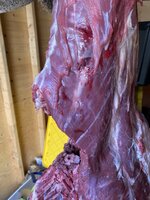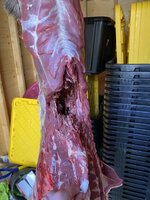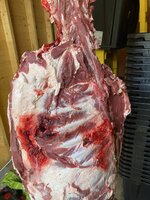- Joined
- Oct 22, 2014
- Messages
- 13,527
I was out a couple weeks back with 6.5 Swede using 140ELD-M on fallow cull hunt. I culled four deer, including a a good sized hind solidly hit at 250m quartering away. She ran off about 75m and tipped over, but came close to tumbling down a steep hill/ravine. Exit wound was not very big, but lungs/liver were shredded.
My experience so far with the 6.5 has been just mediocre. Nothing spectacular about it and you really want solid hits with no room for error. The 6.5 does not put deer down like a .270 or 30-06. However recoil is light so you can be more accurate. Wind deflection is much better than .30 cals once you shoot distance. I need more time with this calibre, but this is my initial impression. If I was on an important big game hunt I'd take my 30-06 or 270 at this stage.
My mate on the other hand has shot a lot of deer with his .260 with 123s at higher velocity and has much faster knockdowns than I had. He uses that rifle for guided clients now for the low recoil.
Another mate that has shot thousands of heads of game just thinks the 6.5s are also so-so. They work fine, but you need to really make sure you have a good shot as margin for error is a lot smaller than larger calibres.
I’m not saying that you experience hasn’t happened, but what do you believe is the difference between .013 inches in bullet diameter on game? It can’t be magical- bullets destroy and/or damage tissue in only a few ways, and the wounding mechanisms are the same regardless of caliber. The wound channels created by .277 and .264 bullets of like weight and design are absolutely identical at same impact speeds; and a 30cal of the same is very marginally larger than either- so marginal that one can not tell by looking at them which did which.
In hundreds of game with each, based on time to incapacitation and distance traveled after the shot; I have not seen any functional differences between like/optimized bullets from .224-7mm, and only noticeable differences when using certain 30cal and .338 bullets at high impact velocities.





